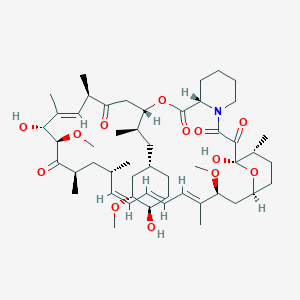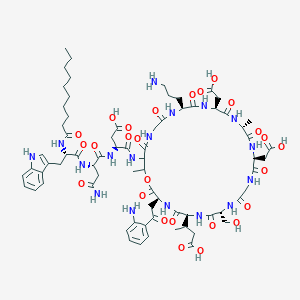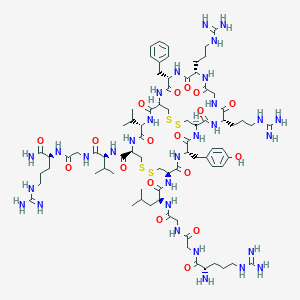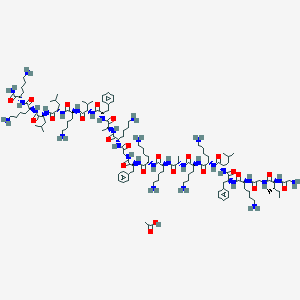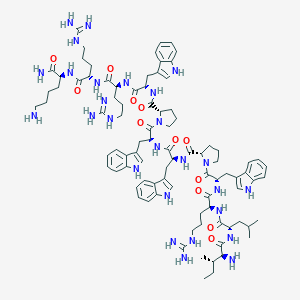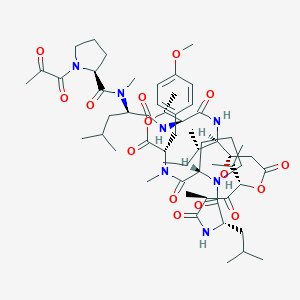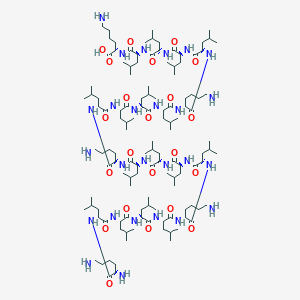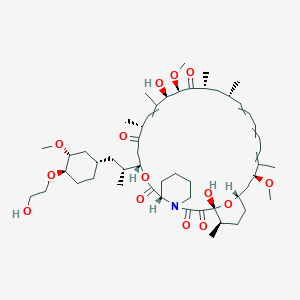
Everolimus
Overview
Description
Everolimus is a derivative of rapamycin, known for its immunosuppressive and anti-proliferative properties. It is primarily used to prevent organ rejection in transplant patients and to treat various types of cancer, including renal cell carcinoma and certain types of breast cancer . This compound works by inhibiting the mammalian target of rapamycin (mTOR), a key protein involved in cell growth and proliferation .
Mechanism of Action
Target of Action
Everolimus, also known as RAD001, primarily targets the mammalian target of rapamycin (mTOR) . mTOR is a serine/threonine kinase that plays a crucial role in regulating cell growth, proliferation, and survival .
Mode of Action
This compound works by forming a complex with the FK506 binding protein-12 (FKBP-12), which inhibits the activation of mTOR . By inhibiting mTOR, this compound disrupts several cellular processes, including protein synthesis and cell cycle progression .
Biochemical Pathways
The mTOR pathway, which this compound inhibits, is involved in several key cellular processes . These include:
By inhibiting mTOR, this compound can disrupt these processes, leading to a decrease in cell growth and proliferation .
Pharmacokinetics
This compound exhibits significant inter-individual pharmacokinetic variability . It is lipophilic and rapidly absorbed into the arterial wall . It is also a substrate of both CYP3A4 and PgP, and inhibits the activity of CYP3A4 . This means that its metabolism can be affected by other drugs that interact with these enzymes .
Result of Action
The inhibition of mTOR by this compound leads to a decrease in cell growth and proliferation . This makes it effective in treating various types of malignancies, including renal cell carcinoma, neuroendocrine tumors, and hormone receptor-positive, HER2-negative breast cancer .
Action Environment
The action of this compound is influenced by environmental factors. The mTOR pathway, which this compound inhibits, regulates cell growth and metabolism in response to environmental factors . Furthermore, the pharmacokinetics of this compound can be affected by factors such as diet and the presence of other drugs .
Biochemical Analysis
Biochemical Properties
Everolimus plays a crucial role in biochemical reactions by inhibiting the mTORC1 protein complex, which is involved in cell growth, proliferation, and survival. It interacts with several enzymes, proteins, and biomolecules, including FK506 binding protein 12 (FKBP12), mTORC1, and hypoxia-inducible factor 1-alpha (HIF-1α). The interaction between this compound and FKBP12 forms a complex that binds to mTORC1, inhibiting its activity. This inhibition leads to a decrease in protein synthesis, cell proliferation, and angiogenesis .
Cellular Effects
This compound affects various types of cells and cellular processes. It influences cell function by inhibiting the mTORC1 pathway, which plays a critical role in cell growth, proliferation, and metabolism. This compound reduces the phosphorylation of downstream targets such as p70S6 kinase and 4E-BP1, leading to decreased protein synthesis and cell cycle progression. It also affects gene expression by downregulating HIF-1α and vascular endothelial growth factor (VEGF), resulting in reduced angiogenesis .
Molecular Mechanism
The molecular mechanism of this compound involves its binding to FKBP12, forming a complex that inhibits mTORC1. This inhibition disrupts the mTOR signaling pathway, leading to reduced protein synthesis, cell growth, and proliferation. This compound also affects other cellular processes such as autophagy, lipid biosynthesis, and mitochondrial biogenesis. By inhibiting mTORC1, this compound reduces the activity of S6 kinase and 4E-BP1, which are essential for protein translation and cell cycle progression .
Temporal Effects in Laboratory Settings
In laboratory settings, the effects of this compound change over time. This compound is stable under physiological conditions, but its degradation can occur in the presence of certain enzymes and environmental factors. Long-term studies have shown that this compound maintains its inhibitory effects on mTORC1, leading to sustained reductions in cell proliferation and angiogenesis. Prolonged exposure to this compound can result in adaptive resistance mechanisms, such as upregulation of alternative signaling pathways .
Dosage Effects in Animal Models
The effects of this compound vary with different dosages in animal models. At low doses, this compound effectively inhibits mTORC1 activity, leading to reduced cell proliferation and angiogenesis. At high doses, this compound can cause toxic effects, including immunosuppression, hyperlipidemia, and impaired wound healing. Studies in animal models have shown that this compound has a dose-dependent effect on tumor growth, with higher doses leading to greater inhibition of tumor progression .
Metabolic Pathways
This compound is involved in several metabolic pathways, including glycolysis, the pentose phosphate pathway, and the tricarboxylic acid cycle. It interacts with enzymes such as hexokinase, phosphofructokinase, and pyruvate kinase, leading to alterations in glucose metabolism. This compound impairs glucose utilization by reducing the activity of key glycolytic enzymes and decreasing the levels of intracellular glycometabolites .
Transport and Distribution
This compound is transported and distributed within cells and tissues through various mechanisms. It is a substrate of the cytochrome P450 enzyme CYP3A4 and the efflux transporter P-glycoprotein (PgP). This compound has a high volume of distribution and is extensively bound to plasma proteins. It is distributed to various tissues, including the liver, kidneys, and lungs. The transport and distribution of this compound are influenced by factors such as drug-drug interactions and genetic polymorphisms .
Subcellular Localization
This compound is localized in various subcellular compartments, including the cytoplasm, endoplasmic reticulum, and mitochondria. It affects the activity and function of these organelles by modulating the mTOR signaling pathway. This compound enhances the expression of proteins involved in microtubule stabilization, such as tubulin beta 2B class IIb (TUBB2B) and doublecortin domain containing 2 (DCDC2), which play a role in maintaining cytoskeletal integrity .
Preparation Methods
Synthetic Routes and Reaction Conditions: Everolimus is synthesized from rapamycin through a series of chemical reactions. The primary synthetic route involves the reaction of rapamycin with ethylene glycol mono trifluoromethanesulfonate under the influence of an organic base. This reaction produces an intermediate compound, which is then subjected to an acetal protection group removal reaction under acidic conditions to yield this compound .
Industrial Production Methods: The industrial production of this compound follows similar synthetic routes but is optimized for higher yields and cost-effectiveness. The process involves the use of inexpensive and readily available reagents, such as ethylene glycol mono trifluoromethanesulfonate, and includes steps for the recycling of unreacted rapamycin to ensure product quality and reduce costs .
Chemical Reactions Analysis
Types of Reactions: Everolimus undergoes various chemical reactions, including oxidation, reduction, and substitution. These reactions are essential for its metabolic processing and therapeutic action.
Common Reagents and Conditions:
Oxidation: Typically involves the use of oxidizing agents like hydrogen peroxide or potassium permanganate.
Reduction: Often carried out using reducing agents such as sodium borohydride or lithium aluminum hydride.
Substitution: Involves nucleophilic or electrophilic reagents under controlled conditions.
Major Products: The primary products formed from these reactions include various metabolites that are further processed in the body to exert their therapeutic effects .
Scientific Research Applications
Everolimus has a wide range of scientific research applications:
Chemistry: Used as a model compound for studying mTOR inhibitors and their chemical properties.
Biology: Investigated for its role in cell growth, proliferation, and survival pathways.
Medicine: Widely used in clinical settings to prevent organ rejection and treat cancers.
Industry: Utilized in drug-eluting stent technologies to prevent restenosis in cardiovascular treatments.
Comparison with Similar Compounds
Sirolimus (Rapamycin): The parent compound of everolimus, used for similar therapeutic purposes but with different pharmacokinetic properties.
Temsirolimus: Another mTOR inhibitor with a similar mechanism of action but used primarily for treating renal cell carcinoma.
Uniqueness of this compound: this compound is unique due to its enhanced oral bioavailability and specific targeting of the mTORC1 protein complex. This specificity allows for more effective inhibition of cell growth and proliferation, making it a valuable therapeutic agent in oncology and transplant medicine .
Properties
CAS No. |
159351-69-6 |
|---|---|
Molecular Formula |
C53H83NO14 |
Molecular Weight |
958.2 g/mol |
IUPAC Name |
(1R)-1,18-dihydroxy-12-[1-[4-(2-hydroxyethoxy)-3-methoxycyclohexyl]propan-2-yl]-19,30-dimethoxy-15,17,21,23,29,35-hexamethyl-11,36-dioxa-4-azatricyclo[30.3.1.04,9]hexatriaconta-16,24,26,28-tetraene-2,3,10,14,20-pentone |
InChI |
InChI=1S/C53H83NO14/c1-32-16-12-11-13-17-33(2)44(63-8)30-40-21-19-38(7)53(62,68-40)50(59)51(60)54-23-15-14-18-41(54)52(61)67-45(35(4)28-39-20-22-43(66-25-24-55)46(29-39)64-9)31-42(56)34(3)27-37(6)48(58)49(65-10)47(57)36(5)26-32/h11-13,16-17,27,32,34-36,38-41,43-46,48-49,55,58,62H,14-15,18-26,28-31H2,1-10H3/t32?,34?,35?,36?,38?,39?,40?,41?,43?,44?,45?,46?,48?,49?,53-/m1/s1 |
InChI Key |
HKVAMNSJSFKALM-VUDSBINYSA-N |
SMILES |
CC1CCC2CC(C(=CC=CC=CC(CC(C(=O)C(C(C(=CC(C(=O)CC(OC(=O)C3CCCCN3C(=O)C(=O)C1(O2)O)C(C)CC4CCC(C(C4)OC)OCCO)C)C)O)OC)C)C)C)OC |
Isomeric SMILES |
CC1CCC2CC(C(=CC=CC=CC(CC(C(=O)C(C(C(=CC(C(=O)CC(OC(=O)C3CCCCN3C(=O)C(=O)[C@@]1(O2)O)C(C)CC4CCC(C(C4)OC)OCCO)C)C)O)OC)C)C)C)OC |
Canonical SMILES |
CC1CCC2CC(C(=CC=CC=CC(CC(C(=O)C(C(C(=CC(C(=O)CC(OC(=O)C3CCCCN3C(=O)C(=O)C1(O2)O)C(C)CC4CCC(C(C4)OC)OCCO)C)C)O)OC)C)C)C)OC |
Appearance |
White to off-white solid powder |
| Everolimus is currently used as an immunosuppressant to prevent rejection of organ transplants. In a similar fashion to other mTOR inhibitors Everolimus' effect is solely on the mTORC1 protein and not on the mTORC2 protein. | |
boiling_point |
998.7±75.0 °C at 760 mmHg |
melting_point |
N/A |
| 159351-69-6 | |
Pictograms |
Health Hazard |
Purity |
>98% (or refer to the Certificate of Analysis) |
shelf_life |
Stable under recommended storage conditions. |
solubility |
Soluble in DMSO, not in water |
storage |
−20°C |
Synonyms |
001, RAD 40-O-(2-hydroxyethyl)-rapamycin Afinitor Certican everolimus RAD 001 RAD, SDZ RAD001 SDZ RAD SDZ-RAD |
Origin of Product |
United States |
Retrosynthesis Analysis
AI-Powered Synthesis Planning: Our tool employs the Template_relevance Pistachio, Template_relevance Bkms_metabolic, Template_relevance Pistachio_ringbreaker, Template_relevance Reaxys, Template_relevance Reaxys_biocatalysis model, leveraging a vast database of chemical reactions to predict feasible synthetic routes.
One-Step Synthesis Focus: Specifically designed for one-step synthesis, it provides concise and direct routes for your target compounds, streamlining the synthesis process.
Accurate Predictions: Utilizing the extensive PISTACHIO, BKMS_METABOLIC, PISTACHIO_RINGBREAKER, REAXYS, REAXYS_BIOCATALYSIS database, our tool offers high-accuracy predictions, reflecting the latest in chemical research and data.
Strategy Settings
| Precursor scoring | Relevance Heuristic |
|---|---|
| Min. plausibility | 0.01 |
| Model | Template_relevance |
| Template Set | Pistachio/Bkms_metabolic/Pistachio_ringbreaker/Reaxys/Reaxys_biocatalysis |
| Top-N result to add to graph | 6 |
Feasible Synthetic Routes
Q1: What is the mechanism of action of everolimus?
A: this compound is a potent inhibitor of the mammalian target of rapamycin (mTOR), specifically mTOR complex 1 (mTORC1) [, , ]. It acts by binding to the FKBP12 protein, forming a complex that inhibits the kinase activity of mTORC1.
Q2: What are the downstream effects of this compound-mediated mTORC1 inhibition?
A2: Inhibition of mTORC1 by this compound leads to a cascade of downstream effects, including:
- Reduced cell proliferation: this compound inhibits the phosphorylation of ribosomal protein S6 kinase (S6K) and eukaryotic initiation factor 4E-binding protein 1 (4E-BP1), key regulators of protein synthesis and cell cycle progression [, ]. This ultimately leads to reduced cell proliferation in various cell types, including tumor cells [, ].
- Inhibition of angiogenesis: this compound downregulates the expression of vascular endothelial growth factor (VEGF), a crucial pro-angiogenic factor, thereby suppressing angiogenesis [, ].
- Modulation of immune response: While not a primary focus in the provided articles, mTORC1 inhibition by this compound has been shown to influence T cell differentiation and function [].
Q3: What is the molecular formula and weight of this compound?
A3: The molecular formula of this compound is C53H83NO14, and its molecular weight is 958.2 g/mol.
Q4: Is there any information available about spectroscopic data for this compound in these research papers?
A4: The provided research papers primarily focus on the clinical and biological aspects of this compound and do not delve into detailed spectroscopic characterization.
Q5: What is known about the stability of this compound?
A: this compound exhibits stability challenges, requiring careful consideration during formulation and storage [, , ].
Q6: What strategies can enhance the stability, solubility, or bioavailability of this compound?
A6: Several formulation approaches are employed to improve this compound's pharmaceutical properties:
- Solid dispersions: By dispersing this compound within a matrix of inert carriers, its dissolution rate and solubility can be enhanced [].
- Nanoparticulate systems: Encapsulating this compound in nanoparticles offers advantages such as improved solubility, controlled release, and potential for targeted delivery [, ].
- Cyclodextrin complexation: Forming complexes with cyclodextrins can increase this compound's aqueous solubility, enhancing its bioavailability [].
Q7: How is this compound absorbed, distributed, metabolized, and excreted (ADME)?
A: this compound is an orally administered drug that demonstrates good absorption but substantial interindividual variability in its pharmacokinetics [, , , ].
- Absorption: this compound is well absorbed after oral administration, reaching peak concentrations in approximately 1-2 hours []. Food intake can influence its absorption [].
- Distribution: It exhibits a large volume of distribution, indicating extensive tissue distribution [].
- Metabolism: this compound is primarily metabolized in the liver by the cytochrome P450 (CYP) 3A4 enzyme [, , ].
- Excretion: It is excreted predominantly in feces, with a small fraction eliminated in urine [].
Q8: How is the therapeutic drug monitoring of this compound conducted?
A: Therapeutic drug monitoring (TDM) of this compound is routinely performed using validated liquid chromatography-tandem mass spectrometry (LC-MS/MS) methods to measure drug levels in whole blood samples [, , ]. This information helps personalize dosage, manage drug interactions, and minimize toxicity.
Q9: Are there known drug interactions with this compound?
A: this compound is a substrate of CYP3A4, and co-administration with CYP3A4 inhibitors or inducers can alter its blood levels [, , , ]. Dosage adjustments might be necessary when used concomitantly with these agents.
Q10: What in vitro and in vivo models have been used to study this compound's anticancer activity?
A10: this compound's anticancer activity has been investigated in various in vitro and in vivo models, including:
- Cell-based assays: Researchers have employed cell proliferation assays, colony formation assays, and spheroid growth assays to assess this compound's inhibitory effects on tumor cell growth [, , ].
- Animal models: this compound has demonstrated efficacy in preclinical animal models of various cancers, including renal cell carcinoma, pancreatic neuroendocrine tumors, and breast cancer [, , , ]. These models provide valuable insights into the drug's pharmacodynamic effects and potential for therapeutic benefit.
Q11: Are there clinical trials demonstrating the efficacy of this compound in cancer treatment?
A11: Yes, several randomized controlled trials have established the efficacy of this compound in specific cancer types:
- Renal cell carcinoma (RCC): this compound has shown significant clinical benefit in patients with advanced RCC who progressed on prior VEGF-targeted therapy, leading to its approval for this indication [, , , , ].
- Pancreatic neuroendocrine tumors (pNETs): this compound has demonstrated significant improvement in progression-free survival in patients with advanced pNETs, leading to its approval for this indication [, , ].
- Breast cancer: this compound, in combination with exemestane, has shown efficacy in postmenopausal women with hormone receptor-positive, HER2-negative metastatic breast cancer resistant to aromatase inhibitor therapy [, , ].
Q12: What are the known mechanisms of resistance to this compound?
A12: Resistance to this compound can develop through various mechanisms, including:
- Activation of alternative signaling pathways: Tumor cells may circumvent mTORC1 inhibition by activating alternative pro-survival and proliferative pathways, such as the PI3K/Akt pathway [, ].
- Mutations in mTOR pathway components: Mutations in genes encoding components of the mTOR pathway, such as mTOR itself or its downstream effectors, can contribute to resistance [, ].
Q13: Are there biomarkers to predict this compound efficacy or monitor treatment response?
A13: Research is ongoing to identify reliable biomarkers for this compound:
- FDG-PET SUV changes: Early changes in standardized uptake value (SUV) on 18F-fluorodeoxyglucose positron emission tomography (FDG-PET) scans might hold promise as a predictive biomarker for long-term benefit in patients with hormone receptor-positive metastatic breast cancer treated with this compound and exemestane [].
Q14: What are the alternatives and substitutes for this compound?
A: Sirolimus (rapamycin), another mTOR inhibitor, shares a similar mechanism of action and has shown comparable efficacy in some clinical settings [, , ]. The choice between this compound and sirolimus often depends on patient-specific factors, treatment history, and the specific clinical scenario.
Disclaimer and Information on In-Vitro Research Products
Please be aware that all articles and product information presented on BenchChem are intended solely for informational purposes. The products available for purchase on BenchChem are specifically designed for in-vitro studies, which are conducted outside of living organisms. In-vitro studies, derived from the Latin term "in glass," involve experiments performed in controlled laboratory settings using cells or tissues. It is important to note that these products are not categorized as medicines or drugs, and they have not received approval from the FDA for the prevention, treatment, or cure of any medical condition, ailment, or disease. We must emphasize that any form of bodily introduction of these products into humans or animals is strictly prohibited by law. It is essential to adhere to these guidelines to ensure compliance with legal and ethical standards in research and experimentation.


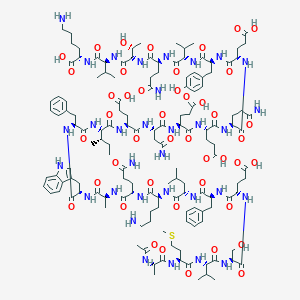
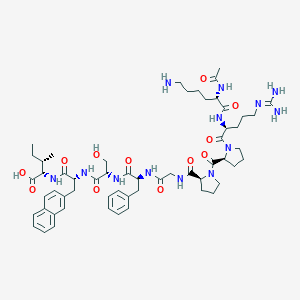
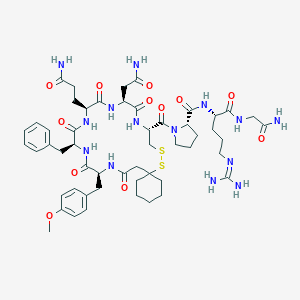
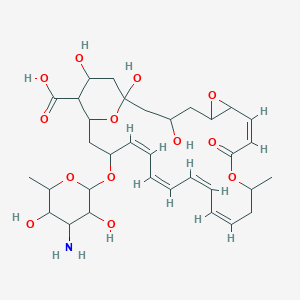
![(2S,3'R,3aS,4S,4'S,5'R,6R,6'R,7S,7aS)-4-[(1R,2S,3R,5S,6R)-3-amino-2,6-dihydroxy-5-(methylamino)cyclohexyl]oxy-6'-[(1R)-1-amino-2-hydroxyethyl]-6-(hydroxymethyl)spiro[4,6,7,7a-tetrahydro-3aH-[1,3]dioxolo[4,5-c]pyran-2,2'-oxane]-3',4',5',7-tetrol](/img/structure/B549156.png)
![Pneumocandin A0, 1-[(4R,5R)-4,5-dihydroxy-N2-(1-oxohexadecyl)-L-ornithine]-4-[(4S)-4-hydroxy-4-[4-hydroxy-3-(sulfooxy)phenyl]-L-threonine]-](/img/structure/B549160.png)
![N-[(3S,9S,11R,18S,20R,21R,24S,25S)-21-(2-Aminoethylamino)-3-[(1R)-3-amino-1-hydroxypropyl]-6-[(1S,2S)-1,2-dihydroxy-2-(4-hydroxyphenyl)ethyl]-11,20,25-trihydroxy-15-[(1R)-1-hydroxyethyl]-2,5,8,14,17,23-hexaoxo-1,4,7,13,16,22-hexazatricyclo[22.3.0.09,13]heptacosan-18-yl]-10,12-dimethyltetradecanamide](/img/structure/B549164.png)
